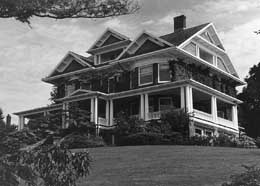In the summer of 1905, Jane Morris Rucker (1830-1907), her sons Wyatt and Bethel, and Bethel's new wife Ruby Brown Rucker move into an imposing new mansion high atop Rucker Hill overlooking downtown Everett. When the Rucker brothers and their mother moved to the peninsula where Everett now stands 15 years earlier, the site was thickly forested and sparsely settled. The Ruckers played a key role in the formation of the Everett Land Company that developed the city, and are profiting handsomely from their interests in real estate, banks, and timber as the boom town grows. In 2008, the Rucker Mansion, added to the National Register of Historic Places in 1975 but still privately owned, stands relatively unchanged above the city the Ruckers helped build.
Many Washington cities grew up quickly, but Everett's rise was faster than most. The peninsula between the Snohomish River estuary and Port Gardner Bay was not exactly a wilderness when the Ruckers arrived in 1889 -- Salish peoples had inhabited it for thousands of years, the principal Snohomish village, Hibulb (or Hebolb), stood for centuries at the peninsula's tip, and a handful of non-Indian settlers had trickled in. Nevertheless, an early historian writing only 14 years later identified Jane Rucker as "the pioneer woman resident of Everett" (the wives of some earlier settlers were Native American), and wrote that when she arrived "[t]he townsite ... was a dense forest, many fir trees more than two hundred and fifty feet high standing where the best business blocks have since been erected" (Prosser, 184).
Deal in Dirt
Jane Rucker and her sons moved from Ohio to Tacoma in 1888. The brothers were "on the lookout for 'deals in dirt'" (Taylor). Wyatt Rucker thought the forested peninsula fronting Port Gardner Bay looked promising, both for the timber and the fact that the Great Northern Railroad was expected to reach Puget Sound around that spot. In the winter of 1889-1890, the Ruckers acquired thousands of acres that would become the site of Everett by purchasing an existing homestead on the bay. They started to plat a town named Port Gardner, but gave that up for more grandiose plans instigated by Tacoma lumberman Henry Hewitt Jr. (1840-1918).
Hewitt brought eastern investors fronted by Charles L. Colby (1839-1896) and including John D. Rockefeller (1839-1937) together with the Ruckers and other local landowners to establish the Everett Land Company and promote an industrial city on the site. The Ruckers transferred half their land to the company, but still had significant property of their own. They profited from the new city's boom in the early 1890s, in part because they were able to market the first platted lots in Everett in September 1891, some months before the company's lots were ready.
The Ruckers survived the economic panics of the later 1890s and were positioned to prosper when boom times resumed around 1900. They played an instrumental role in the 1899 deal in which Rockefeller's Everett Land Company sold its interests to the Everett Improvement Company controlled by James J. Hill (1838-1916), head of the Great Northern Railway. Wyatt Rucker served as treasurer of the new company. In addition to their real estate holdings, the Ruckers had interests in several banks and prospered in the timber industry.
Building a Mansion
Everett doubled in size (to 16,000) between 1900 and 1905. By 1904, along with harbor improvements and industrial expansion, the city was in the midst of a residential building frenzy. The Rucker Mansion, built high on a plateau southwest of downtown with sweeping 180-degree views of the city, harbor, and Cascade and Olympic mountains, was just the most prominent of many substantial homes under construction that year. The large brick home, with a wood frame veranda wrapping three sides, cost $40,000 to construct. The builder (whose identity is not known) combined a number of architectural styles including Italian Villa, Queen Anne, and Georgian Revival. In addition to the sumptuously decorated main floor and the second-floor bedroom suites, the mansion included a basement cardroom and billiard room and a third-floor ballroom.
According to local legend recounted in National Register of Historic Places paperwork, Rucker Mansion was built as a wedding gift for Ruby Brown, the daughter of an Everett realtor who married Bethel Rucker on December 24, 1904. If so, the present came with some strings attached, since Ruby Rucker would share the home with her mother-in-law and brother-in-law. The mansion was supposed to be finished by the time Bethel and Ruby returned from a three-month Asian honeymoon in the spring of 1905. However, work was still ongoing in July 1905, and it is not known exactly when that summer the family began living in their new home.
Jane Rucker died in the home at age 77, two years after the family moved in. In 1923, the Ruckers sold the home to Clyde Walton, who headed a local lumber company, for a reported price of $32,500, somewhat less than they had paid to construct it. Walton and his family lived in the home until his death in 1959. In 1975, the home, located at 412 Laurel Drive, was added to the National Register of Historic Places. It remains a private residence.

